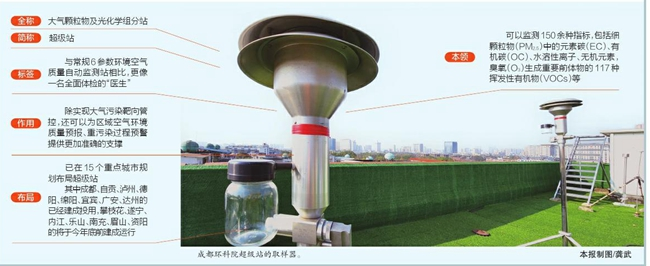Super stations in eight cities, including Chengdu, have been put into use, and the other seven super stations will be built before the end of the year to run air health check-up "doctors" to help targ

Compared with the ordinary monitoring station, it is more like a "doctor" with a comprehensive physical examination. It can not only monitor more than 150 indicators, but also find out the cause of air pollution and explain it clearly … At the press conference held by the Department of Ecology and Environment on March 7, the sub-station of Atmospheric Particulate Matter and Photochemistry Group (hereinafter referred to as Super Station) walked from behind the scenes to the front.
Super stations have been planned and laid out in 15 key cities in Sichuan. Among them, the super stations in 8 cities including Chengdu have been put into use, and the remaining 7 super stations will be completed and put into operation before the end of this year. By then, a super station monitoring network will be basically formed in the whole province to realize targeted control of air pollution.
More than 150 indicators can be monitored to find out the "cause" of air pollution.
Due to the special topography, meteorology, industry, energy, traffic structure and other comprehensive factors, the prevention and control of air pollution in Sichuan Basin has entered a "deep water period", and it is necessary to move the real thing and "chew the hard bone" one by one.
How to dig?
"Targeted control is very important!" Lei Yi, deputy director of the Department of Ecology and Environment, said that based on the basic completion of the atmospheric environmental quality monitoring network, the Department of Ecology and Environment will increase the construction of super stations from 2020 to further clarify and understand the components of atmospheric pollutants and realize scientific pollution control.
So, where is the super station "super"?
At the press conference, Lei Yi made an image metaphor. "Compared with the conventional 6-parameter automatic monitoring station for ambient air quality, the super station is more like a’ doctor’ with a comprehensive physical examination." Lei Yi said that the super station can monitor more than 150 kinds of indicators, including elemental carbon (EC), organic carbon (OC), water-soluble ions and inorganic elements in fine particulate matter (PM2.5), and 117 kinds of volatile organic compounds (VOCs) generated by ozone (O3). "The cause of air pollution can be clearly identified and explained." Lei Yi said.
At present, Sichuan has planned and laid out super stations in 15 key cities, among which super stations in Chengdu, Zigong, Luzhou, Deyang, Mianyang, Yibin, Guang ‘an and Dazhou have been put into use. The super stations in Panzhihua, Suining, Neijiang, Leshan, Nanchong, Meishan and Ziyang will be completed and put into operation before the end of this year. By then, a super station monitoring network will be basically formed in the whole province, which will provide more powerful support for deepening the blue sky defense war.
"Targeted pollution control" to achieve maximum environmental benefits at minimum cost.
In the winter of 2022, the concentration of water-soluble substances such as sulfate, organic carbon, elemental carbon and heavy metal iron in the air pollution in Deyang City was high, which contributed greatly to the concentration of PM2.5 in the urban area … Facing the atmospheric "disease", the Super Station accurately "felt the pulse" and found out the "cause": the characteristic pollution sources mainly came from industries such as coal burning and smelting. The targeted management and control plan was quickly released: relevant departments strengthened the management and control of enterprises such as steel and glass. When the medicine reaches the disease, the related pollutants are effectively controlled.
In addition to "targeted pollution control", the super station can also provide more accurate support for regional air environmental quality prediction and early warning of heavy pollution process.
Qi Qiang, chief engineer of the provincial ecological environment monitoring station, said that accurate early warning and forecasting have laid a good foundation for the prevention and control of air pollution, leaving enough space and gaining time for the process of dealing with polluted weather. The data shows that in 2022, the accuracy of air quality grade forecast in the next three days in the province will be 89.3%. After the completion of the super station in Mianyang, the accuracy of air quality grade forecast reached 95%.
Lei Yi said that relying on the super station, the local party committees and governments can carry out their work in a targeted manner, achieve precise control, and achieve maximum environmental benefits at the least cost.
A full-time and full-coverage atmospheric environmental quality monitoring network has been basically established.
Ecological environment monitoring is the basic work of ecological environment protection. "We have basically built a full-time, full-coverage atmospheric environmental quality monitoring network." Lei Yi said that the completion of such a network provides an important basis for assessing the improvement of environmental quality and the effectiveness of environmental pollution control in various places.
At present, there are 308 national and provincial air quality automatic monitoring stations in the province, and there is one national and provincial air quality automatic monitoring station every 25 square kilometers in the built-up areas of cities at or above the county level to monitor the ambient air quality of cities at or above the county level in real time. The eco-environment department also cooperates closely with meteorological departments to establish the Southwest Regional Air Quality Forecast Center, which can realize the forecast of air quality grade in the next 14 days at the provincial level and the forecast of major pollutants concentration in the next 7 days at prefecture-level cities. (Reporter   Tian Chengchen)